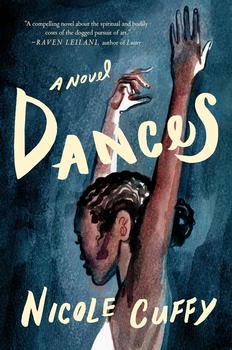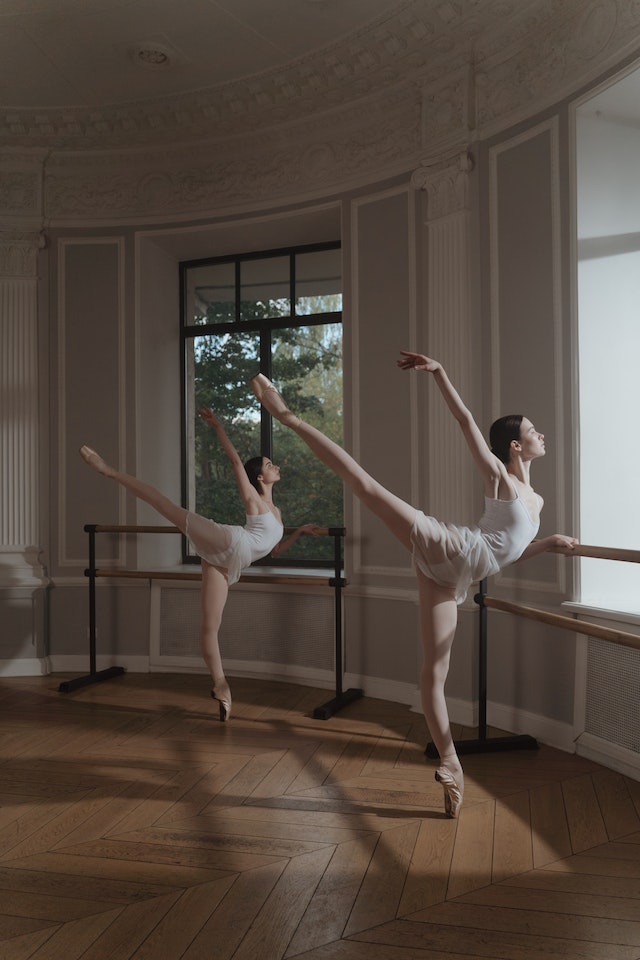Summary | Excerpt | Reading Guide | Reviews | Beyond the Book | Read-Alikes | Genres & Themes | Author Bio

A Novel
by Nicole CuffyThis article relates to Dances
 Dances by Nicole Cuffy is a novel filled with the mechanics of ballet. Through the first-person narration of her protagonist Cece, Cuffy portrays the everyday rhythms and realities of dance, creating patterns and scenes with its terminology. While the physicality of this language is an art to be enjoyed in itself, having even a cursory knowledge of a few words for various poses and movements can help readers visualize the action Cuffy describes on the page: "And croisé fondu to the front, croisé fondu to the back, plié—use the floor—passé, and développé à la seconde, arabesque, into retiré and rond, double rond with plié, sous-sus, pas de bourrée into fifth, and pirouette, and again—go for double—and soutenu, other side."
Dances by Nicole Cuffy is a novel filled with the mechanics of ballet. Through the first-person narration of her protagonist Cece, Cuffy portrays the everyday rhythms and realities of dance, creating patterns and scenes with its terminology. While the physicality of this language is an art to be enjoyed in itself, having even a cursory knowledge of a few words for various poses and movements can help readers visualize the action Cuffy describes on the page: "And croisé fondu to the front, croisé fondu to the back, plié—use the floor—passé, and développé à la seconde, arabesque, into retiré and rond, double rond with plié, sous-sus, pas de bourrée into fifth, and pirouette, and again—go for double—and soutenu, other side."
Ballet terms are generally in the French language. While the dance form began in 15th-century Renaissance Italy, it came to France in the 16th century via Catherine de Medici, who married French King Henry II. In 1661, King Louis XIV started the first formal school of ballet, the Académie Royal de Danse. Along with his instructor Pierre Beauchamp, he also created the "cinq positions des pieds," the five basic positions of the feet that are still used in ballet today, of which Cece refers to the fifth above.
In Première Position (prweh-mee-AIR po-ziss-ee-ONH, First Position), a dancer stands with their legs together and feet splayed outward. In Seconde Position (suh-GUND, Second Position), the feet are moved further apart. In Troisième Position (twah-zee-EM, Third Position), one foot comes to rest in front of the other, heel to arch. In Quatrième Position (kat-trwee-EM, Fourth Position), the feet are once again spread apart. In Cinquième Position (sank-ee-EM, Fifth Position), the front foot returns to rest in front of the back foot, heel to toe.
Arabesque (air-uh-BESK) — A pose in which a dancer stands on one leg while holding the other leg straight out behind them.
Attitude (ah-tee-TEWD) — This pose is similar to the arabesque, but the raised leg is bent.
Croisé (krwah-ZAY) — A position where the legs appear crossed to the audience.
Développé (day-vehl-uh-PAY) — A highly controlled "developing movement" in which one leg is pulled up and slowly extended. "Développé à la seconde" refers to a développé from Second Position, in which the leg is extended to the side.
Fondu (fahn-DEWH) — A sinking or lowering of the body. "Fondu" literally means "melted" or "molten," hence the Swiss dish of melted cheese.
Jeté (juh-TAY) — A step that involves springing from one leg to the other.
Pas de bourrée (pah duh boo-RAY) — A move that involves walking or running on the tips of the toes.
Passé (pah-SAY) — This refers to the action of the leg passing through the "retiré" position (see below).
Penché(e) (pahn-SHAY) — Leaning. In an "arabesque penché," a dancer is bent forward with their leg raised behind them.
Pirouette (peer-uh-WET) — A turn or "whirl" of the body on one foot.
Plié (plee-AY) — Bent, referring to a bending of the knee. A "demi-plié" is a "half-bend."
Pointe (pwant) — Used in the phrase "en pointe" ("on pointe") to describe the lifting of the body onto the tips of the toes. "Demi-pointe," or "half-pointe," refers to being on the balls of the feet.
Promenade (prwaw-muh-NAHD) — Used in the phrase "tour de promenade," this refers to a dancer turning slowly on one foot while holding a particular pose.
Relevé (ruh-luh-VAY) — Raised. Used to refer to raising one's body on pointe or demi-pointe.
Retiré (ruh-tee-RAY) — In retiré, one leg is raised to the side with a bent knee, the foot held at the knee of the supporting leg.
Rond (rawnh) — A rond, or "rond de jambe," describes a move in which one leg extends away from the body in a straight line and then executes a semi-circular motion.
Sous-sus (soo-SEWH) — This step typically involves a rising (relevé) on pointe or demi-pointe in Fifth Position.
Soutenu (soo-teh-NEWH) — This refers to a rotation executed from a sous-sus/raised Fifth Position that also ends in this position.
Tendu (tawn-DEWH) — A tendu, or "battement tendu," is a stretching of the leg that brings the foot into a pointed position while remaining on the floor.
For more terms, along with audio for some pronunciations, visit the American Ballet Theatre's ballet dictionary.
Watch the video below to see a dancer going through some of the moves and positions.
Filed under Music and the Arts
![]() This "beyond the book article" relates to Dances. It originally ran in June 2023 and has been updated for the
March 2024 paperback edition.
Go to magazine.
This "beyond the book article" relates to Dances. It originally ran in June 2023 and has been updated for the
March 2024 paperback edition.
Go to magazine.
Your guide toexceptional books
BookBrowse seeks out and recommends the best in contemporary fiction and nonfiction—books that not only engage and entertain but also deepen our understanding of ourselves and the world around us.